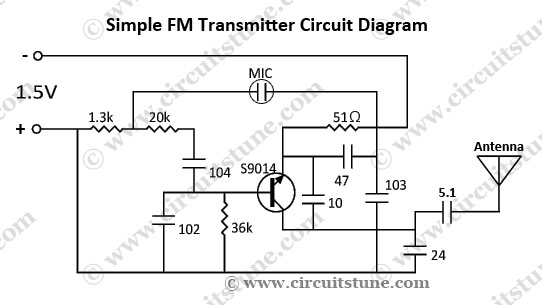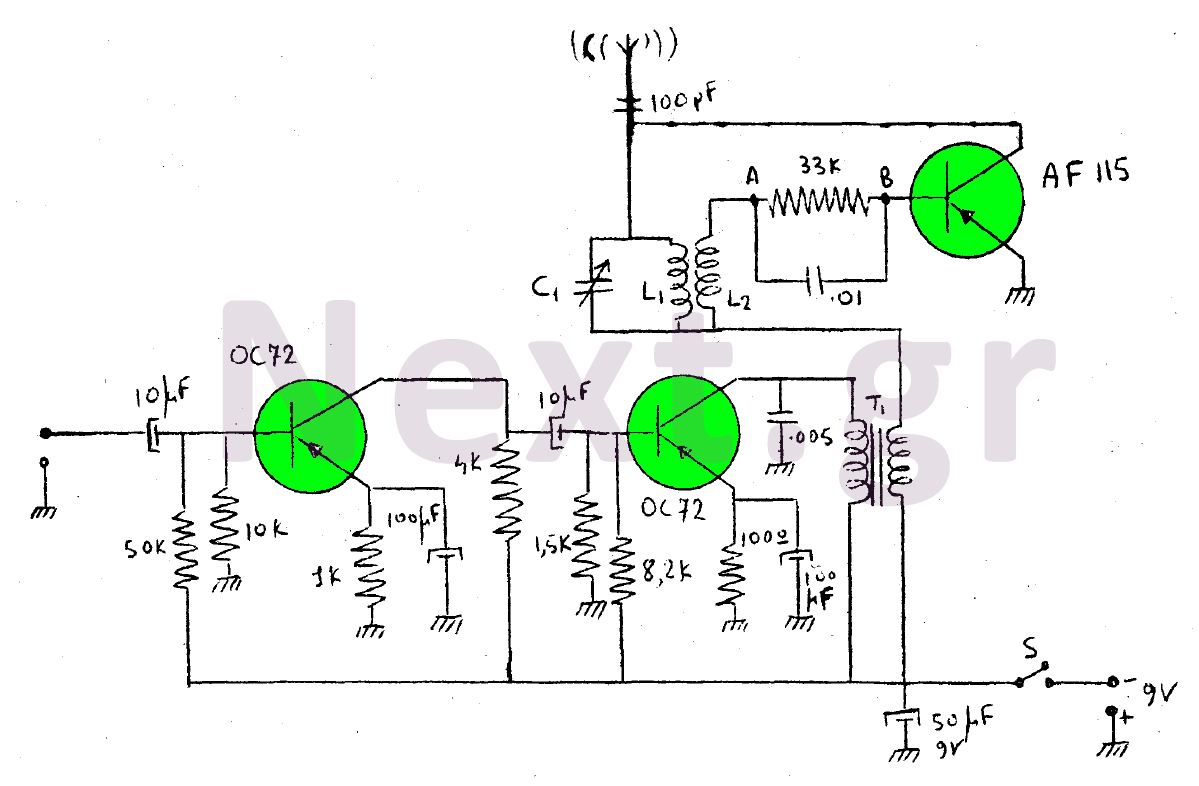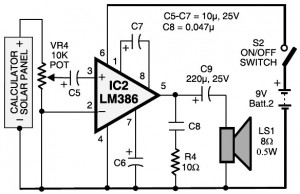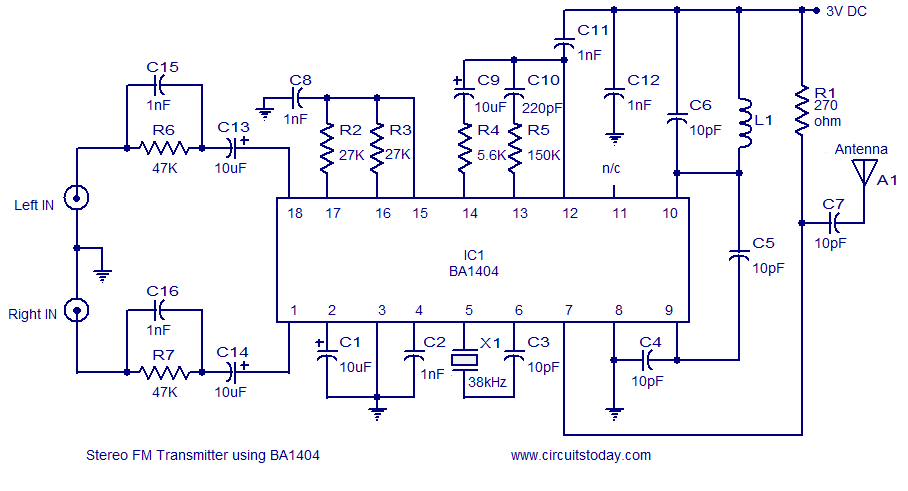
CW Transmitter
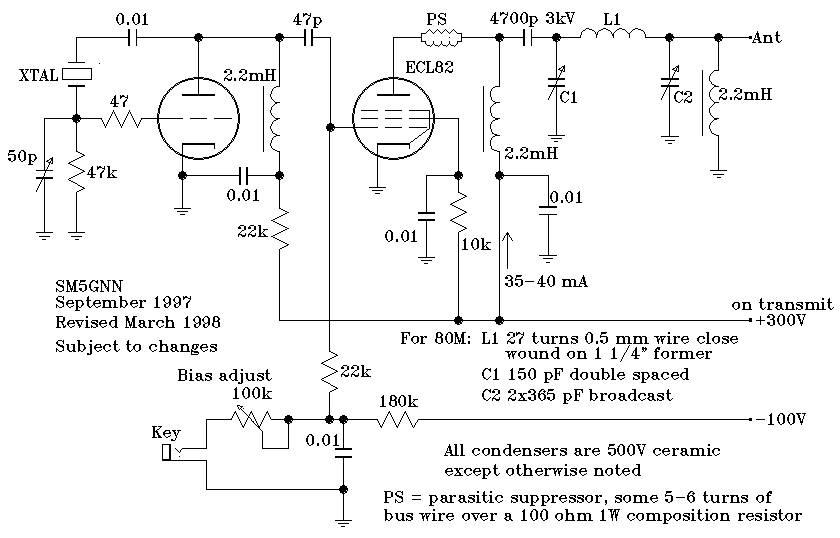
This one-valve (ECL82) CW Transmitter occupies a very special place in my amateur radio history. I was first licensed in 1994 but did not operate on air. I committed to only ever operate equipment which I had made myself. I had no time for radio construction and several years passed. In early 2002 I came across a design by Jan Axing, SM5GNN and decided to build it. The transmitter worked first time and tuning was exactly as Jan had said it would be. At the same time, I built a solid state HF receiver using various new and unusual techniques such as a Tayloe switching mixer, Huff & Puff stabilised VFO and polyphase audio phase shift network for unwanted sideband cancellation. My first ever QSO was on 25'th March 2002. Over the next few years I made a number of modifications to the transmitter, and it remained my ONLY transmitter for over three and a half years! During this time I made over 550 QSO's, many of which were long ragchews lasting an hour or two. The little ECL82 valve has served well! More: I had a nice QSO on 80m with Hans-Peter, DL9EBA. Like me, he was using a homemade one-valve transmitter (not the same design as my TX). It uses a Philips EBL21 valve and produces an output of 2W on 80m. It is crystal controlled and also operates on the 30 and 40m bands. The sound was great! Visit DL9EBA's Transmitter page! In German, with pictures, or the English text version. I finished to build the ECL82 transmitter and it transmit very well with abt 8 watts on 80m and 40m. The photos and the drawing are on my site: http://f6hcc.free.fr . I have used and adapted your drawing. Hans-Peter DL9EBA kindly sent me this recording he made. You will hear 30 seconds of my one-valve CW transmitter in operation from my QTH (near London, England), during an 80m CW QSO on 30-Nov-02 with Rene ON4KAR (in Mettet, Belgium). Both stations reported 579 and were using 5W QRP power, G0UPL to a longwire antenna and ON4KAR to a G5RV. The recording from Hans-Peter's QTH in Rheinhausen, Germany was made using the 100Hz mechanical filter of his EKD Receiver. There is some QRM from an SSB USB station on QRG, this allocation is shared with other services at times, in this case most probably Danish fishermen. The preceeding QSO to this one was with Hans-Peter DL9EBA, our second QSO. This recording can be downloaded in MP3 format by clicking here to visit the web page of Mike Andrews W5EGO. Mike kindly offered to host the files since I have limited space on this server and in any case it does not allow me to host MP3 files. Thanks Mike! Be sure to take a look around the rest of Mike's interesting website.
The one-valve ECL82 CW transmitter is a notable design in the realm of amateur radio, particularly for its simplicity and effectiveness in generating continuous wave (CW) signals. The ECL82 tube, a triode-pentode configuration, is primarily utilized for its excellent linearity and low distortion in RF applications. This transmitter is capable of producing approximately 8 watts of output power, making it suitable for operation on the 80m and 40m amateur bands.
The circuit typically includes a crystal oscillator for frequency stability, which is essential for CW operation. A Tayloe switching mixer may be integrated within the design to facilitate smooth frequency conversion, ensuring that the desired signal is effectively generated while unwanted sidebands are minimized. The inclusion of a Huff & Puff stabilized variable frequency oscillator (VFO) further enhances the stability of the transmitted signal, providing a reliable means to maintain frequency accuracy during operation.
The audio processing section may employ a polyphase audio phase shift network, which serves to cancel out unwanted sidebands, thus improving the overall quality of the transmitted signal. This is particularly beneficial in CW transmissions, where signal clarity is paramount for effective communication.
The transmitter's construction allows for modifications and adaptations, which can lead to improved performance based on user experience and preferences. The design's flexibility has enabled operators to engage in numerous QSOs, demonstrating its reliability and effectiveness in real-world applications. The successful operation of the ECL82 transmitter, as evidenced by numerous QSOs and positive reports from other operators, underscores its value within the amateur radio community.
The integration of a longwire antenna or G5RV dipole can further enhance transmission capabilities, allowing for effective communication over varying distances. Overall, the ECL82 CW transmitter represents a significant achievement in amateur radio construction, combining simplicity with effective performance.This one-valve (ECL82) CW Transmitter occupies a very special place in my amateur radio history. I was first licensed in 1994 but did not operate on air. I committed to only ever operate equipment which I had made myself. I had no time for radio construction and several years passed. In early 2002 I came across a design by Jan Axing, SM5GNN and decided to build it. The transmitter worked first time and tuning was exactly as Jan had said it would be. At the same time, I built a solid state HF receiver using various new and unusual techniques such as a Tayloe switching mixer, Huff & Puff stabilised VFO and polyphase audio phase shift network for unwanted sideband cancellation. My first ever QSO was on 25'th March 2002. Over the next few years I made a number of modifications to the transmitter, and it remained my ONLY transmitter for over three and a half years!
During this time I made over 550 QSO's, many of which were long ragchews lasting an hour or two. The little ECL82 valve has served well! I had a nice QSO on 80m with Hans-Peter, DL9EBA. Like me, he was using a homemade one-valve transmitter (not the same design as my TX). It uses a Philips EBL21 valve and produces an output of 2W on 80m. It is crystal controlled and also operates on the 30 and 40m bands. The sound was great! Visit DL9EBA's Transmitter page! In German, with pictures, or the English text version. I finished to build the ECL82 transmitter and it transmit very well with abt 8 watts on 80m and 40m. The photos and the drawing are on my site: http://f6hcc.free.fr . I have used and adapted your drawing. Hans-Peter DL9EBA kindly sent me this recording he made. You will hear 30 seconds of my one-valve CW transmitter in operation from my QTH (near London, England), during an 80m CW QSO on 30-Nov-02 with Rene ON4KAR (in Mettet, Belgium). Both stations reported 579 and were using 5W QRP power, G0UPL to a longwire antenna and ON4KAR to a G5RV.
The recording from Hans-Peter's QTH in Rheinhausen, Germany was made using the 100Hz mechanical filter of his EKD Receiver. There is some QRM from an SSB USB station on QRG, this allocation is shared with other services at times, in this case most probably Danish fishermen.
The preceeding QSO to this one was with Hans-Peter DL9EBA, our second QSO. This recording can be downloaded in MP3 format by clicking here to visit the web page of Mike Andrews W5EGO. Mike kindly offered to host the files since I have limited space on this server and in any case it does not allow me to host MP3 files.
Thanks Mike! Be sure to take a look around the rest of Mike's interesting website. 🔗 External reference
The one-valve ECL82 CW transmitter is a notable design in the realm of amateur radio, particularly for its simplicity and effectiveness in generating continuous wave (CW) signals. The ECL82 tube, a triode-pentode configuration, is primarily utilized for its excellent linearity and low distortion in RF applications. This transmitter is capable of producing approximately 8 watts of output power, making it suitable for operation on the 80m and 40m amateur bands.
The circuit typically includes a crystal oscillator for frequency stability, which is essential for CW operation. A Tayloe switching mixer may be integrated within the design to facilitate smooth frequency conversion, ensuring that the desired signal is effectively generated while unwanted sidebands are minimized. The inclusion of a Huff & Puff stabilized variable frequency oscillator (VFO) further enhances the stability of the transmitted signal, providing a reliable means to maintain frequency accuracy during operation.
The audio processing section may employ a polyphase audio phase shift network, which serves to cancel out unwanted sidebands, thus improving the overall quality of the transmitted signal. This is particularly beneficial in CW transmissions, where signal clarity is paramount for effective communication.
The transmitter's construction allows for modifications and adaptations, which can lead to improved performance based on user experience and preferences. The design's flexibility has enabled operators to engage in numerous QSOs, demonstrating its reliability and effectiveness in real-world applications. The successful operation of the ECL82 transmitter, as evidenced by numerous QSOs and positive reports from other operators, underscores its value within the amateur radio community.
The integration of a longwire antenna or G5RV dipole can further enhance transmission capabilities, allowing for effective communication over varying distances. Overall, the ECL82 CW transmitter represents a significant achievement in amateur radio construction, combining simplicity with effective performance.This one-valve (ECL82) CW Transmitter occupies a very special place in my amateur radio history. I was first licensed in 1994 but did not operate on air. I committed to only ever operate equipment which I had made myself. I had no time for radio construction and several years passed. In early 2002 I came across a design by Jan Axing, SM5GNN and decided to build it. The transmitter worked first time and tuning was exactly as Jan had said it would be. At the same time, I built a solid state HF receiver using various new and unusual techniques such as a Tayloe switching mixer, Huff & Puff stabilised VFO and polyphase audio phase shift network for unwanted sideband cancellation. My first ever QSO was on 25'th March 2002. Over the next few years I made a number of modifications to the transmitter, and it remained my ONLY transmitter for over three and a half years!
During this time I made over 550 QSO's, many of which were long ragchews lasting an hour or two. The little ECL82 valve has served well! I had a nice QSO on 80m with Hans-Peter, DL9EBA. Like me, he was using a homemade one-valve transmitter (not the same design as my TX). It uses a Philips EBL21 valve and produces an output of 2W on 80m. It is crystal controlled and also operates on the 30 and 40m bands. The sound was great! Visit DL9EBA's Transmitter page! In German, with pictures, or the English text version. I finished to build the ECL82 transmitter and it transmit very well with abt 8 watts on 80m and 40m. The photos and the drawing are on my site: http://f6hcc.free.fr . I have used and adapted your drawing. Hans-Peter DL9EBA kindly sent me this recording he made. You will hear 30 seconds of my one-valve CW transmitter in operation from my QTH (near London, England), during an 80m CW QSO on 30-Nov-02 with Rene ON4KAR (in Mettet, Belgium). Both stations reported 579 and were using 5W QRP power, G0UPL to a longwire antenna and ON4KAR to a G5RV.
The recording from Hans-Peter's QTH in Rheinhausen, Germany was made using the 100Hz mechanical filter of his EKD Receiver. There is some QRM from an SSB USB station on QRG, this allocation is shared with other services at times, in this case most probably Danish fishermen.
The preceeding QSO to this one was with Hans-Peter DL9EBA, our second QSO. This recording can be downloaded in MP3 format by clicking here to visit the web page of Mike Andrews W5EGO. Mike kindly offered to host the files since I have limited space on this server and in any case it does not allow me to host MP3 files.
Thanks Mike! Be sure to take a look around the rest of Mike's interesting website. 🔗 External reference
